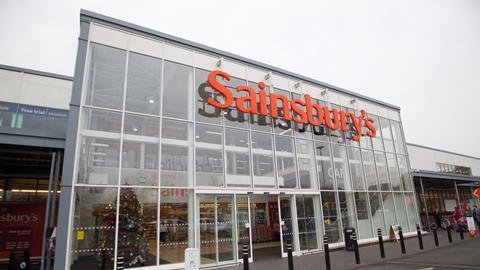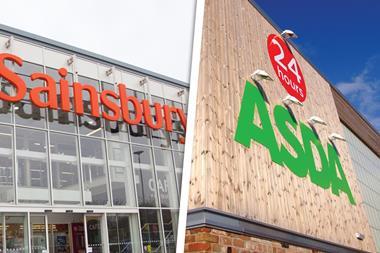The CMA has delivered a crushing blow to the proposed merger between Sainsbury’s and Asda after it found the deal would lead to higher prices at store across the UK.
Here is what experts say about the CMA’s Phase 2 provisional findings.
Clive Black, Shore Capital:
“In provisional findings that potentially create retail history, the CMA looks minded to reject the proposed merger of Sainsbury & Asda. Whilst we need to see if Sainsbury and Asda can argue and legally challenge the CMA’s findings, the deal looks to have suffered a mortal blow; the CMA struggles to see how remedies can deliver its view of a competitive UK market. Indeed, Sainsbury’s angry reaction to the CMA’s announcements, which we need to read in detail, reflects the mood but also perhaps is a little detached. We believe it is bordering on laughable for the Group to state; ‘We are surprised that the CMA would choose to reject the opportunity to put money directly into customers’ pockets’ when we always felt that 10% price cuts on unspecified products on an unspecified timeframe was playing to the galleries. Sainsbury looks like it has misunderstood the consumer and the CMA.
“For Walmart this is a headache that requires plan B, although we sense that there will be more smiles in Leeds than Holborn. “
Jonathan Branton, head of EU and competition at DWF:
“The CMA has taken a clearly tough stance in its approach to the proposed merger between Sainsbury’s and Asda. It has raised a significant number of difficult questions at both national and local (individual store) levels and given the national issues in particular, this raises doubts as to whether Sainsbury’s and Asda would be able (or willing) to give the solutions the CMA appears to need before it would to give an approval. The significant concerns the CMA has published today therefore do not bode well for an ultimate approval of the deal.”
James Brown, head of the retail & consumer goods practice at Simon-Kucher:
“Many suppliers will breathe a sigh of relief on hearing that the Competition & Markets Authority (CMA) seems to be moving towards rejecting the merger
“This looks like good news for suppliers and - if we believe the CMA’s analysis - for shoppers too.
“The argument from Sainsbury’s and Asda that reducing competition would lead to lower prices was always going to be tough. That can work if you can make substantial cost savings - but how much more can really be squeezed from grocery suppliers?
“For branded suppliers it was mostly stick and no carrot. There is very little benefit suppliers can take from a merger, mostly they will lose volume sales.
“For private labels (own brand), the chance to win big new contracts could be powerful and have led to real cost savings. Though how much more efficient it is to manufacture to serve 29% of the market versus 15% is up for debate.
“Put simply, the CMA’s modelling - which we expect Sainsburys and Asda to challenge both in terms of method and outcomes - shows that any likely cost savings from the merger won’t offset the incentives to increase price.
“Sainsbury’s and Asda are extremely confident in their ability to deliver lower prices - the CMA is clearly less so and we can expect that to be the focus for the remainder of the investigation.”
Nick Bubb, independent analyst:
“The headline of the summary statement is “Sainsbury’s/Asda merger could push up prices and reduce quality” and the conclusion is clear: “the merger could lead to a substantial lessening of competition at both a national and local level”. We can’t see a number on the potential store disposals, but the CMA’s view on the remedies is brutal: “…sell off a significant number of stores and other assets - potentially including one of the Sainsbury’s or Asda brands - to recreate the competitive rivalry lost through the merger. The CMA’s current view is that it is likely to be difficult for the companies to address the concerns it has identified”.
Ratula Chakraborty, professor of business management at UEA’s Norwich Business School University of East Anglia:
“Today’s announcement by the CMA on the provisional findings on the proposed Sainsbury’s-Asda merger should come as no surprise.
“The parties may protest loudly but it would be absolute madness for the authorities to allow a merger that along with Tesco would create a duopoly stranglehold which would inevitably lessen competition and be bad for consumers.
“I see no way back for the parties against the strength of these provisional findings and I expect that the merger will be completely blocked when the CMA reaches its final decision at the end of April.”
Richard Curry, partner at Rapleys:
“In the cold light of day, the clear fact is that the CMA’s role in this is to ensure competition is maintained in a market where there aren’t really that many competitors of similar enough ilk to be considered credible, and fewer still who are likely to be interested in any Sainsbury’s or Asda stores in a fire sale of stores.
Particularly when you factor in the fuel retail element, the only two alternatives that offer the same product range and shopping experience are Tesco and Morrisons – who are unlikely to be interested in enough of the large format stores likely to be seen as problematic by the CMA to make a difference.
The CMA’s provisional findings do increase the likelihood of the Sainsbury’s-Asda deal being scrapped. However, Walmart will clearly still be looking to offload Asda and there will likely be other suitors waiting in the wings. The left field, but potentially realistic, option is Amazon. Clearly the online juggernaut is looking at its UK strategy, with the launch of its first cashier-less Amazon Go store outside of the US in London. With its Wholefoods business going strong, there could be a surprise splash around the corner. The irony of course is that Walmart is seeking to offload Asda as part of its domestic strategy to see-off competition from Amazon; by consolidating its position at home, Walmart could cede ground to Amazon internationally…
Clearly Sainsbury’s will robustly defend the proposed deal. The CMA have extended the deadline for its final decision to the end of May, but this could drag on far longer if there is any appeal. The challenge for Sainsbury’s is that Walmart may feel a better outcome can be found elsewhere, which the CMA will doubtless welcome as a solution given the complexities it is trying to navigate. “
Jordan Hiscott, chief trader at Ayondo Markets:
“The tie up with Asda had the potential to finally allow the company to compete with Tesco and against the smaller German rivals Lidl and Aldi. The future of the merger now looks almost completely doomed and I suspect Sainsbury will have to reassess its next move to compete in the supermarket sector.”
Paul Hickman, analyst at Edison Investment Research:
“The CMA’s provisional finding t places significant doubt on the merger succeeding. An important strand in the CMA’s reasoning is that there is significant competition between the “big four” supermarkets that is necessarily compromised if you go from four to three. But that is irrespective of the fact that Tesco has 27.7% market share, nearly twice as much as Sainsbury (15.9%), and even more against Asda (15.3%) and Morrisons (10.6%). The finding appears to rubber stamp the severe imbalance in existing market shares.
“The finding that, now that Aldi and Lidl are included, the number of locations where competition is substantially lessened, has now risen from 463 in the September interim report, to 629 looks on the face of it inconsistent. This may be because the CMA, in its more detailed calculations, has taken a pricing level of 2.5% to represent “substantial” lessening of competition. This needs to be set against Sainsbury’s undertaking to lessen prices on “many” of its “everyday” items by up to 10%. To be fair, this is not a very specific or quantifiable promise by Sainsbury, although there is scope out of the merger synergies for it to be substantial. The CMA has defined what it thinks as the potential pricing benefit as 1%. This leaves it open for Sainsbury and Asda to firm up their commitment at a higher level.
“On the other hand the CMA points out that Asda’s convenience stores charge the same as their supermarkets, while Tesco charges higher prices. That may be the case, but the price factor is probably much less of an issue in the convenience market because of, well, convenience.”
Laith Khalaf, senior analyst at Hargreaves Lansdown:
‘The CMA has basically kicked the Sainsbury-Asda merger into touch. While the regulator left the door open for the supermarkets to sell off assets to complete the deal, it’s clearly not keen on that solution.
The supermarkets will now have to bend over backwards if they want to proceed with the merger, and even then, wouldn’t be guaranteed a favourable ruling from the CMA. The thorny issue of competition in the online delivery market also means they may have to get rid of one of the brands, reducing their ability to target different customer bases.
They also have to find a suitable buyer for the assets on sale, one who is big enough to provide proper competition in the eyes of the regulator.
There’s an incredibly delicate balance to be struck here, because the CMA is also concerned that if the supermarkets do sell enough assets to proceed with the merger, the combined entity may damage competition by being too weak, rather than too strong.
Sainsbury shares have fallen significantly as hopes for the merger have collapsed. It’s an ill wind indeed which blows no-one any good, but that seems to be the order of the day in the supermarket sector with Tesco, and Morrison selling off too.
This suggests the market is concerned Walmart may now seek to sell off Asda to another party, and there may not even be the silver lining of some shops being sold off to soften the blow.’
Richard Lim, chief executive at Retail Economics:
“These provisional findings deliver a hammer blow to the potential tie-up between Sainsbury’s and Asda. Protecting the interests of consumers is paramount and the CMA chose not to mix its words with the second phase finding extensive competition concerns. The scope of any potential recommendations in the final stage may be too much to swallow for the deal to survive.
“There’s no doubt that the industry is amid a painful readjustment. Competition in the industry is fiercer than ever before and at the heart of this proposed deal is the need to drive further efficiencies through scale. What emerges between whom and when remains highly uncertain, but we expect plentiful conversations between retailers and wholesalers, wholesalers and symbols groups and even large-scale logistics companies?”
David McCarthy, global head of consumer retail research, HSBC
“The provisional findings make glum reading for Sainsbury’s with the takeover of Asda likely to be blocked, in our view. The CMA has found there would be, on a balance of probabilities, a substantial lessening of competition (SLC) in supermarkets, online and convenience stores, leading to a worse experience for shoppers across the UK through higher prices, a poorer shopping experience, and reductions in the range and quality of products. It also has concerns that prices could rise at a large number of Sainsbury/Asda petrol stations.
Prohibition is a comprehensive solution to these concerns and risks are low. The CMA recognises that store disposals as a remedy would bring risks and specifies strict criteria on who could buy a large package of stores, for example: a single buyer, independent of Sainsbury’s or Asda, proven management team, would not create further competition concerns, etc. The CMA’s view is that identifying a purchaser may be difficult. We would suggest Morrisons is the only potential candidate, but this would likely create further local and national concerns. We see no overseas or private equity buyer. Blocking the deal is, therefore, the most likely outcome. The implied number of store disposals would make the deal unattractive/unprofitable for Sainsbury’s.
Sainsbury’s has invested a lot into the proposed takeover: management time, cash and reputation. The business has been distracted and is in a worse position tactically and strategically than a year ago. “
Bruno Monteyne, senior analyst at Bernstein:
“it looks like bad news for the deal, with close to the worst possible outcome.
Whilst these are provisional findings and it gives Sainsbury’s/Asda (and other stakeholders) an opportunity to respond, neither options laid out by the CMA seem particularly rosy.
We think there is a real chance for Sainsbury’s to go to court on the CMA findings, after the final findings and assuming we are still in the situation of a bad outcome for the deal. This will further drag out the uncertainty about the deal and be a distraction for the Sainsbury’s investment thesis and possibly Sainsbury’s management.
In addition people will worry that the Asda deal implied that survival on a stand-alone will be very hard. In addition some investors may raise concerns over Mike Coupe’s leadership (completely unjustified in our view).”
Patrick O’Brien, UK retail research director at GlobalData:
“The CMA’s provisional findings on the proposed merger of Asda and Sainsbury’s have devastated any prospect of the merger going ahead. Rather than just point to a number of stores that would need to be divested as had been expected, the CMA has raised concerns about the tie-up in just about every conceivable way – on national and local grounds, on store and online competition concerns and on major stores, convenience stores and petrol stations. The CMA even outlined how difficult the required level of divestments needed would be to action.
“It seems that the CMA didn’t buy the central strategy of the deal: that it would benefit consumers by using their combined might to negotiate down major suppliers and pass on much of the benefit to shoppers in reduced prices.
“While Sainsbury’s CEO Mike Coupe vows to fight on, this may be because he cannot concede without losing face. The confidence he placed in getting the deal past the CMA in light of its previous - generous - decision to allow Tesco to buy Booker looks like a bad misjudgement now, and recent results have seen Sainsbury’s fall behind its rivals, inviting the suggestion that management have taken their eye off the ball.”




















No comments yet